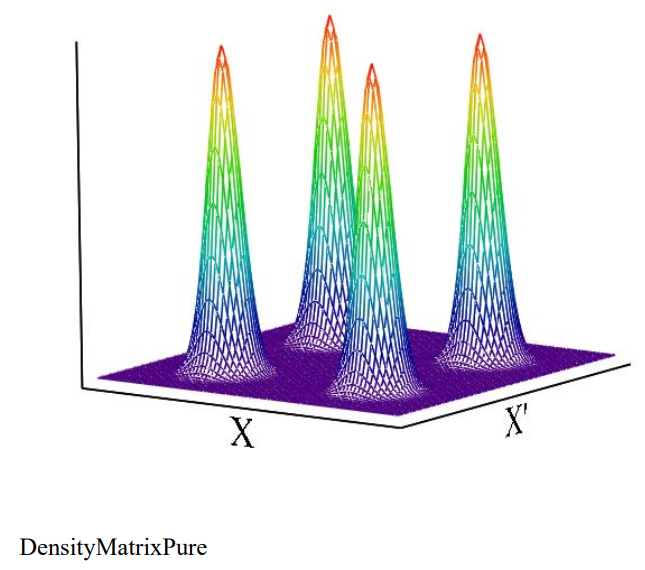1.99: Visualizing the Difference Between a Superposition and a Mixture
- Page ID
- 158605
\( \newcommand{\vecs}[1]{\overset { \scriptstyle \rightharpoonup} {\mathbf{#1}} } \)
\( \newcommand{\vecd}[1]{\overset{-\!-\!\rightharpoonup}{\vphantom{a}\smash {#1}}} \)
\( \newcommand{\id}{\mathrm{id}}\) \( \newcommand{\Span}{\mathrm{span}}\)
( \newcommand{\kernel}{\mathrm{null}\,}\) \( \newcommand{\range}{\mathrm{range}\,}\)
\( \newcommand{\RealPart}{\mathrm{Re}}\) \( \newcommand{\ImaginaryPart}{\mathrm{Im}}\)
\( \newcommand{\Argument}{\mathrm{Arg}}\) \( \newcommand{\norm}[1]{\| #1 \|}\)
\( \newcommand{\inner}[2]{\langle #1, #2 \rangle}\)
\( \newcommand{\Span}{\mathrm{span}}\)
\( \newcommand{\id}{\mathrm{id}}\)
\( \newcommand{\Span}{\mathrm{span}}\)
\( \newcommand{\kernel}{\mathrm{null}\,}\)
\( \newcommand{\range}{\mathrm{range}\,}\)
\( \newcommand{\RealPart}{\mathrm{Re}}\)
\( \newcommand{\ImaginaryPart}{\mathrm{Im}}\)
\( \newcommand{\Argument}{\mathrm{Arg}}\)
\( \newcommand{\norm}[1]{\| #1 \|}\)
\( \newcommand{\inner}[2]{\langle #1, #2 \rangle}\)
\( \newcommand{\Span}{\mathrm{span}}\) \( \newcommand{\AA}{\unicode[.8,0]{x212B}}\)
\( \newcommand{\vectorA}[1]{\vec{#1}} % arrow\)
\( \newcommand{\vectorAt}[1]{\vec{\text{#1}}} % arrow\)
\( \newcommand{\vectorB}[1]{\overset { \scriptstyle \rightharpoonup} {\mathbf{#1}} } \)
\( \newcommand{\vectorC}[1]{\textbf{#1}} \)
\( \newcommand{\vectorD}[1]{\overrightarrow{#1}} \)
\(\newcommand{\ket}[1]{\left| #1 \right>} \)
\( \newcommand{\bra}[1]{\left< #1 \right|} \)
\( \newcommand{\braket}[2]{\left< #1 \vphantom{#2} \right| \left. #2 \vphantom{#1} \right>} \)
\( \newcommand{\qmvec}[1]{\mathbf{\vec{#1}}} \)
\( \newcommand{\op}[1]{\hat{\mathbf{#1}}}\)
\( \newcommand{\expect}[1]{\langle #1 \rangle}\)
\( \newcommand{\vectorDt}[1]{\overrightarrow{\text{#1}}} \)
\( \newcommand{\vectE}[1]{\overset{-\!-\!\rightharpoonup}{\vphantom{a}\smash{\mathbf {#1}}}} \)
\( \newcommand{\vecs}[1]{\overset { \scriptstyle \rightharpoonup} {\mathbf{#1}} } \)
\( \newcommand{\vecd}[1]{\overset{-\!-\!\rightharpoonup}{\vphantom{a}\smash {#1}}} \)
\(\newcommand{\avec}{\mathbf a}\) \(\newcommand{\bvec}{\mathbf b}\) \(\newcommand{\cvec}{\mathbf c}\) \(\newcommand{\dvec}{\mathbf d}\) \(\newcommand{\dtil}{\widetilde{\mathbf d}}\) \(\newcommand{\evec}{\mathbf e}\) \(\newcommand{\fvec}{\mathbf f}\) \(\newcommand{\nvec}{\mathbf n}\) \(\newcommand{\pvec}{\mathbf p}\) \(\newcommand{\qvec}{\mathbf q}\) \(\newcommand{\svec}{\mathbf s}\) \(\newcommand{\tvec}{\mathbf t}\) \(\newcommand{\uvec}{\mathbf u}\) \(\newcommand{\vvec}{\mathbf v}\) \(\newcommand{\wvec}{\mathbf w}\) \(\newcommand{\xvec}{\mathbf x}\) \(\newcommand{\yvec}{\mathbf y}\) \(\newcommand{\zvec}{\mathbf z}\) \(\newcommand{\rvec}{\mathbf r}\) \(\newcommand{\mvec}{\mathbf m}\) \(\newcommand{\zerovec}{\mathbf 0}\) \(\newcommand{\onevec}{\mathbf 1}\) \(\newcommand{\real}{\mathbb R}\) \(\newcommand{\twovec}[2]{\left[\begin{array}{r}#1 \\ #2 \end{array}\right]}\) \(\newcommand{\ctwovec}[2]{\left[\begin{array}{c}#1 \\ #2 \end{array}\right]}\) \(\newcommand{\threevec}[3]{\left[\begin{array}{r}#1 \\ #2 \\ #3 \end{array}\right]}\) \(\newcommand{\cthreevec}[3]{\left[\begin{array}{c}#1 \\ #2 \\ #3 \end{array}\right]}\) \(\newcommand{\fourvec}[4]{\left[\begin{array}{r}#1 \\ #2 \\ #3 \\ #4 \end{array}\right]}\) \(\newcommand{\cfourvec}[4]{\left[\begin{array}{c}#1 \\ #2 \\ #3 \\ #4 \end{array}\right]}\) \(\newcommand{\fivevec}[5]{\left[\begin{array}{r}#1 \\ #2 \\ #3 \\ #4 \\ #5 \\ \end{array}\right]}\) \(\newcommand{\cfivevec}[5]{\left[\begin{array}{c}#1 \\ #2 \\ #3 \\ #4 \\ #5 \\ \end{array}\right]}\) \(\newcommand{\mattwo}[4]{\left[\begin{array}{rr}#1 \amp #2 \\ #3 \amp #4 \\ \end{array}\right]}\) \(\newcommand{\laspan}[1]{\text{Span}\{#1\}}\) \(\newcommand{\bcal}{\cal B}\) \(\newcommand{\ccal}{\cal C}\) \(\newcommand{\scal}{\cal S}\) \(\newcommand{\wcal}{\cal W}\) \(\newcommand{\ecal}{\cal E}\) \(\newcommand{\coords}[2]{\left\{#1\right\}_{#2}}\) \(\newcommand{\gray}[1]{\color{gray}{#1}}\) \(\newcommand{\lgray}[1]{\color{lightgray}{#1}}\) \(\newcommand{\rank}{\operatorname{rank}}\) \(\newcommand{\row}{\text{Row}}\) \(\newcommand{\col}{\text{Col}}\) \(\renewcommand{\row}{\text{Row}}\) \(\newcommand{\nul}{\text{Nul}}\) \(\newcommand{\var}{\text{Var}}\) \(\newcommand{\corr}{\text{corr}}\) \(\newcommand{\len}[1]{\left|#1\right|}\) \(\newcommand{\bbar}{\overline{\bvec}}\) \(\newcommand{\bhat}{\widehat{\bvec}}\) \(\newcommand{\bperp}{\bvec^\perp}\) \(\newcommand{\xhat}{\widehat{\xvec}}\) \(\newcommand{\vhat}{\widehat{\vvec}}\) \(\newcommand{\uhat}{\widehat{\uvec}}\) \(\newcommand{\what}{\widehat{\wvec}}\) \(\newcommand{\Sighat}{\widehat{\Sigma}}\) \(\newcommand{\lt}{<}\) \(\newcommand{\gt}{>}\) \(\newcommand{\amp}{&}\) \(\definecolor{fillinmathshade}{gray}{0.9}\)The superposition principle, as Feynman said, is at the heart of quantum mechanics. While its mathematical expression is simple, its true meaning is difficult to grasp. For example, given a linear superposition (not normalized) of two states,
\[
|\Psi\rangle=|\phi_{1}\rangle+\left|\phi_{2}\right\rangle
\nonumber \]
one might assume that it represents a mixture of \(\phi_{1}\) and \(\phi_{2}\). In other words, half of the quons [1] are in state \(\phi_{1}\) and half in \(\phi_{2}\). However, the correct quantum mechanical interpretation of this equation is that the system represented by \(\Psi\) is simultaneously in the states \(\phi_{1}\) and \(\phi_{2}\), properly weighted.
A mixture, half \(\phi_{1}\) and half \(\phi_{2}\), or any other ratio, cannot be represented by a wavefunction. It requires a density operator, which is a more general quantum mechanical construct that can be used to represent both pure states (superpositions) and mixtures, as shown below.
\[
\hat{\rho}_{\max }=|\Psi\rangle\langle\Psi|\qquad \hat{\rho}_{\min d}=\sum p_{i}| \Psi_{i}\rangle\langle\Psi_{i}|
\nonumber \]
In the equation on the right, pi is the fraction of the mixture in the state \(\Psi_{i}\).
To illustrate how these equations distinguish between a mixture and a superposition, we will consider a superposition and a mixture of equally weighted gaussian functions representing one-dimensional wave packets. The normalization constants are omitted in the interest of mathematical clarity. The gaussians are centered at x = \(\pm\) 4.
\[
\phi_{1}(x) :=\exp \left[-(x+4)^{2}\right] \qquad \phi_{2}(x) :=\exp \left[-(x-4)^{2}\right]
\nonumber \]

To visualize how the density operator discriminates between a superposition and a mixture, we calculate its matrix elements in coordinate space for the 50-50 superposition and mixture of \(\phi_{1}\) and \(\phi_{2}\). The superposition is considered first.
\[
\Psi(x) :=\phi_{1}(x)+\phi_{2}(x)
\nonumber \]
The matrix elements of this pure state are calculated as follows.
\[
\rho_{\text {pure}}=\left\langle x|\hat{\rho}_{\text {pure}}| x^{\prime}\right\rangle=\langle x | \Psi\rangle\left\langle\Psi | x^{\prime}\right\rangle
\nonumber \]
Looking at the right side we see that the matrix elements are the product of the probability amplitudes of a quon in state \(\Psi\) being at x and xʹ. Next we display the density matrix graphically.
\[
\operatorname{DensityMatrixPure}\left(x, x^{\prime}\right) :=\Psi(x) \cdot \Psi\left(x^{\prime}\right)
\nonumber \]
\[
x_{0}=8 \qquad N :=80 \qquad i :=0 \ldots N \\ \mathrm{x}_{\mathrm{i}} :=-\mathrm{x}_{0}+\frac{2 \cdot \mathrm{x}_{0} \cdot \mathrm{i}}{\mathrm{N}} \qquad \mathrm{j} :=0 \ldots \mathrm{N} \qquad \mathrm{x}_{\mathrm{j}}^{\prime} :=-\mathrm{x}_{0}+\frac{2 \cdot \mathrm{x}_{0} \cdot \mathrm{j}}{\mathrm{N}}
\nonumber \]
\[
\operatorname{DensityMatrixPure}_{\mathrm{i},\mathrm{j}} : = \operatorname{DensityMatrixPure}\left(x, x^{\prime}\right)
\nonumber \]

The presence of off-diagonal elements in this density matrix is the signature of a quantum mechanical superposition. For example, from the quantum mechanical perspective bi-location is possible.
Now we turn our attention to the density matrix of a mixture of gaussian states.
\[
\rho_{\operatorname{mix}}=\left\langle x\left|\hat{\rho}_{\operatorname{mix}}\right| x^{\prime}\right\rangle=\sum_{i} p_{i}\left\langle x | \phi_{i}\right\rangle\left\langle\phi_{i} | x^{\prime}\right\rangle=\frac{1}{2}\left\langle x | \phi_{1}\right\rangle\left\langle\phi_{1} | x^{\prime}\right\rangle+\frac{1}{2}\left\langle x | \phi_{2}\right\rangle\left\langle\phi_{2} | x^{\prime}\right\rangle
\nonumber \]
\[
\operatorname{DensityMatrixMix}(\mathrm{x}, \mathrm{x'}) :=\frac{\phi_{1}(\mathrm{x}) \cdot \phi_{1}(\mathrm{x'})+\phi_{2}(\mathrm{x}) \cdot \phi_{2}\left(\mathrm{x'}^{\prime}\right)}{2}
\nonumber \]
\[
\operatorname{DensityMatrixMix}_{\mathrm{i},\mathrm{j}} : = \operatorname{DensityMatrixMix}\left(x, x^{\prime}\right)
\nonumber \]

The obvious difference between a superposition and a mixture is the absence of off-diagonal elements, \(\phi_{1}(\mathrm{x}) \cdot \phi_{2}\left(\mathrm{x}^{\prime}\right)+\phi_{2}(\mathrm{x}) \cdot \phi_{1}\left(\mathrm{x}^{\prime}\right)\), in the mixed state. This indicates the mixture is in a definite but unknown state; it is an example of classical ignorance.
An equivalent way to describe the difference between a superposition and a mixture, is to say that to calculate the probability of measurement outcomes for a superpostion you add the probability amplitudes and square the sum. For a mixture you square the individual probability amplitudes and sum the squares.
1. Nick Herbert (Quantum Reality, page 64) suggested ʺquonʺ be used to stand for a generic quantum object. ʺA quon is any entity, no matter how immense, that exhibits both wave and particle aspects in the peculiar quantum manner.

